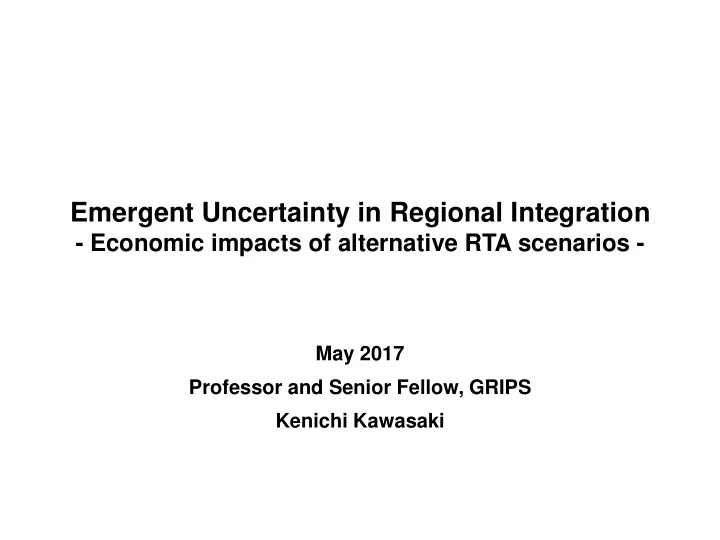

Emergent Uncertainty in Regional Integration - Economic impacts of alternative RTA scenarios - May 2017 Professor and Senior Fellow, GRIPS Kenichi Kawasaki 29 October 2011
Overview • The US would no longer gain and might even lose, if the US withdraws from TPP. • The benefits of the bilateral FTA with Japan would be smaller than those of TPP. • China would lose seriously, if the US imposes a high tariff on imports from China either unilaterally or bilaterally. • China’s benefits from RCEP might be relatively limited depending on the levels of the agreement. • The UK’s cost of Brexit could be smaller than the possible benefits of joining TPP. 1
Impacts of EPAs The impacts of structural reforms measures including EPAs will be achieved over medium-term and contributing to sustainable growth. Economic impacts of trade liberalization GDP Without liberalization With trade liberalization Impacts (%) Trade liberalization Future 2
Regional integration in Asia-Pacific Negotiations on the Regional Comprehensive Economic Partnership (RCEP) began in 2013. The Trans-Pacific Partnership (TPP) negotiations concluded in 2015. Framework of EPAs in Asia-Pacific APEC RCEP Hong Kong, China Chinese Taipei China Russia Korea TPP US Japan India Canada Australia Mexico New Zealand ASEAN Chile Peru Burunei Malaysia Singapore Viet Nam Papua New Guinea Indonesia Cambodia Philippines Laos Thailand Myanmar 3
Impacts of Asia-Pacific EPAs TPP and RCEP are shown to complement each other rather than be competitors towards the establishment of FTAAP. Changes in real GDP: APEC economies % 4.0 Tariff removals 3.5 Tariff removals and NTM reductions 3.0 2.5 2.0 1.5 1.0 0.5 0.0 TPP12 RCEP FTAAP ________________ Source: Kawasaki (2017), “Emergent Uncertainty in Regional Integration”, GRIPS Discussion Paper 16 -28 4
Key economies of FTAAP China would generate the largest income gains from FTAAP followed by the US. Contributions to real GDP gains of FTAAP: APEC economies % 0.8 Tariff removals 0.7 Tariff removals and NTM reductions 0.6 0.5 0.4 0.3 0.2 0.1 0.0 ________________ Source: Kawasaki (2017), “Emergent Uncertainty in Regional Integration”, GRIPS Discussion Paper 16 -28 5
Alternative scenarios of TPP: US The US’ gains not joining TPP would be limited. The US might lose by tariff reductions of the other TPP countries. The US’ benefits by the bilateral FTA with Japan would be a half of TPP. Changes in real GDP: US % 0.8 Tariff reductions 0.7 NTM reductions 0.6 0.5 0.4 0.3 0.2 0.1 0.0 -0.1 TPP12 TPP11 JA-US ________________ Source: Kawasaki (2017), “Emergent Uncertainty in Regional Integration”, GRIPS Discussion Paper 16 -28 6
Alternative scenarios of TPP: Japan Income gains by tariff reductions would largely be reduced, if the US would not join TPP. That said, the benefits by NTM reductions would not be so smaller including spill-over effects to third countries. Changes in real GDP: Japan % 1.2 Tariff reductions 1.0 NTM reductions 0.8 0.6 0.4 0.2 0.0 TPP12 TPP11 JA-US ________________ Source: Kawasaki (2017), “Emergent Uncertainty in Regional Integration”, GRIPS Discussion Paper 16 -28 7
Impacts of US tariffs: US A 45% tariff on imports from China would much more significantly deteriorate the US real GDP than a 35% tariff on imports from Mexico. Changes in real GDP: US % 0.5 0.0 -0.5 -1.0 unilateral -1.5 reciprocal -2.0 TPP China Mexico ________________ Source: Kawasaki (2017), “Emergent Uncertainty in Regional Integration”, GRIPS Discussion Paper 16 -28 8
Impacts of US tariffs: China The US’ 45% tariff on imports from China will seriously deteriorate Chinese real GDP compared with the possible gains from RCEP tariff and NTM reductions. Changes in real GDP: China % 2.0 1.0 0.0 -1.0 -2.0 Tariffs -3.0 Tariffs and NTMs -4.0 US' tariff RCEP ________________ Source: Kawasaki (2017), “Emergent Uncertainty in Regional Integration”, GRIPS Discussion Paper 16 -28 9
Impacts of Brexit: UK The UK’s Brexit cost would be serious depending on the EU border measures, those adverse impacts could be more than offset by tariff reductions joining TPP. Changes in real GDP: UK % 0.4 0.2 0.0 -0.2 -0.4 -0.6 -0.8 -1.0 BREXIT BREXIT EPA EPA EPA WTO EFTA JA-UK US-UK TPP-UK ________________ Source: Kawasaki (2017), “Emergent Uncertainty in Regional Integration”, GRIPS Discussion Paper 16 -28 10
Impacts of Brexit: US Income gains from bilateral tariff reductions with the EU would be 15 per cent smaller after Brexit. The spillover effects of NTM reductions with the UK would be large enough. Changes in real GDP: US % % Tariff removals NTM reductions 0.15 0.5 0.4 0.10 0.3 0.2 0.05 0.1 0.00 0.0 US-EU-UK US-EU US-UK US-EU-UK US-EU US-UK ________________ Source: Kawasaki (2017), “Emergent Uncertainty in Regional Integration”, GRIPS Discussion Paper 16 -28 11
Recommend
More recommend